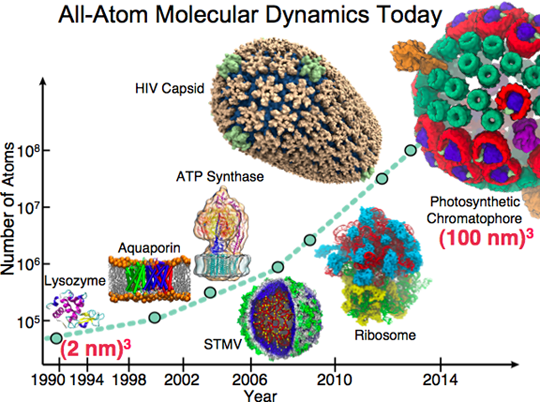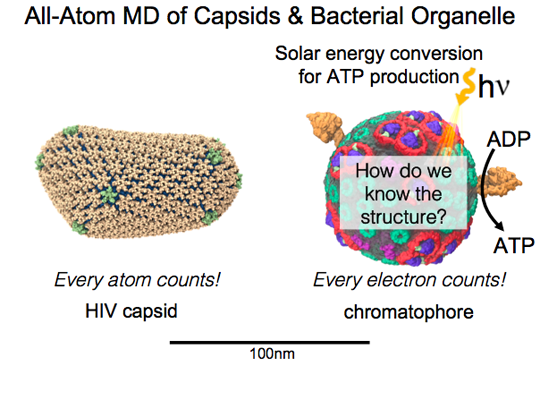Historical Series: National Lecture
Klaus Schulten Reflects on his 2015 National Lecture
By Lisa Pollack16 April 2015
“The point I wanted to make,” says Klaus Schulten about the National Lecture, “is that basically molecular modeling came of age, and it's now a full member of the scientific community in the sense that we can play the most glorious and important part of science, namely to make discoveries.” Schulten thought long and hard before he settled on a title. He finally chose, “Discoveries in Biophysics through the Computational Microscope.” Schulten wanted to specifically bring in the computational microscope because he believes computational biophysics has progressed to the point where it can be called a microscope; namely, it yields a realistic view of biological cellular components at the molecular level, often offering a resolution not available through other instruments. The computational microscope can go all the way to the atomic level, and sometimes even to the electronic level.

Example Slide. Size is a very natural progress variable in biology.
Schulten has seen the computational microscope evolve considerably in the last two decades. First, he has witnessed many skeptics of computational biophysics over the years. People told him that one cannot make discoveries because the simulations cannot be trusted and the best one could do is agree with experiment. It was an aim of the Lecture to point out the successes of the computational microscope, and even to highlight where this unorthodox instrument was ahead of experiment in terms of making a discovery. On top of that, the computational microscope is often the only way to get a dynamic view of a cellular process. In Schulten's talk he highlighted this dynamic view by showing, among many examples, how individual water molecules change their orientation as they pass through aquaporin, how the muscle protein titin actually unfolds when stretched, or seeing the intermediate states as an amyloid-beta fibril elongates.
As Schulten has witnessed the evolution of computational biophysics in the past two decades, that front row seat compelled him to take a certain perspective in the Lecture. Namely, he says, “size is a very natural progress variable in biology.” To understand why system size is so important, Schulten points out that it is in the nature of biological systems to actually form aggregates of many components. For example, a biological cell is made up of complex and huge societies of molecules. While sometimes the smallest member of society (an individual molecule) may play a role, it is more typical for larger groupings (like families or factories) to contribute to the processes in a cell. Schulten feels it is natural to move from the atom all the way to the whole organism, and his focus on increasing system size is because he wants to describe biological organization–how cellular societies function, interact and cooperate hierarchically. In the National Lecture Schulten showed a slide (at right) that charted the timeline of progress in system size; it started with individual proteins, moving to a protein embedded in its membrane host, to an entire ribosome and then to a virus capsid, and finally culminating with a small organelle, the photosynthetic chromatophore. These systems started at about 10,000 atoms in 1990 and progressed to the 100-million-atom mark in 2014.
While Schulten wanted to make the point that as systems become larger and larger they more accurately reflect natural biological societies, he wanted to also reiterate the point that chemical detail matters. What he means by “chemical detail” is the atomic level interactions that undergird biological processes such as a translating ribosome or a virus capsid recruiting cellular factors. For large systems like the ribosome or capsid, one might think that only the bigger things matter, but Schulten's point is that chemical detail is just as important as system size grows, maybe even more so than for a small protein. In fact, Schulten tells a story in the Lecture about the referees who denied his request to do an all-atom simulation of the HIV capsid, instead urging him to coarse grain. Schulten then goes on to reveal how critical the chemical detail was for studies on the capsid, discussing all the things learned from resolving the capsid in full atomic detail. Schulten has seen the important role of detail at the large size, and this compels him to now do the best possible molecular dynamics simulation in terms of the quality of the physical description. In other words, as his National Lecture examples demonstrated, one doesn't forsake chemical detail at a large size.
When the Lights Dimmed
Schulten has given a few lectures to large crowds numbering in the thousands, but this one was very different for him, and a bit more pressure packed. Although he gave keynote talks at the International Supercomputing Conference (5,000 attendees) and the NVIDIA GTC (10,000 attendees), these audiences were computer and technology people interested in what kind of research is being served by leading-edge computer science technology. But the National Lecture (3,000 attendees) was given in front of other biophysicists and, as Schulten says, “this one was very different, and a more challenging lecture because it was given to my own colleagues.” In fact, Schulten knew a great many people in the audience, both as collaborators and by reputation.
There were other challenges as well. The lecture was scheduled at night, so Schulten knew the talk had to be in a relaxed format, perhaps suggesting why he employed humor throughout the evening while speaking.
And it is the longest talk he ever gave, as the allotted time span was 1.5 hours. With so much material covered in such a long talk, Schulten realized a few days before the National Lecture that he could not memorize all the slides, of which there were several dozen. Instead, he had to respond spontaneously to the slides at the moment that each was displayed. “But I felt that was good, because that way it was a natural process. It was a scientist telling his science story, the way it unfolded for him when the slides came,” reiterates Schulten.

Example Slide. The HIV Capsid and the Photosynthetic Chromatophore: Chemical Detail Matters.
Just because he didn't memorize the slides that doesn't mean Schulten didn't prepare. No, exactly the opposite is true. Schulten and his group worked on the lecture and making the slides for over a month; everything else ground to a halt in Illinois. “What was really the most remarkable thing about the lecture was actually that the lecture was the lecture of the group, not the lecture of Klaus Schulten,” he notes. The slides used in the Lecture were heavily based on movies of dynamic processes of biomolecules. Schulten said he and his group felt like Hollywood people, considering every tiny detail of the movie presentations: How long should this clip show? Should we run it forward then backward? Where do we place it?
How did Schulten choose topics from a forty-year career? He limited his talk to matters mostly concerning molecular dynamics, although sometimes he went beyond this, like his discussion of quantum mechanics at finite temperature or the energy levels of the carotenoids he discovered at Harvard in 1972. However, Schulten has been doing molecular dynamics simulations for over twenty years; how did he choose from among this array? As for his selection process, Schulten says, “they really had to be discoveries; one had to explain clearly what we looked for, what was then discovered; and the scientific issue had to be easily and quickly explained.” Namely, Schulten wanted to highlight convincing success stories from molecular dynamics. As some of those success stories were from the late 1990s, Schulten also wanted to pick topics that would be of interest to someone in 2015, that people would still be excited by decades later. Some of those topic included: mechanical proteins (titin, cadherin, and cellulosomes), aquaporin, the ribosome, the HIV capsid, and the many proteins of the photosynthetic chromatophore. (For an overview of the content, with numerous excerpts of the slides, see this website: Scientific Content of National Lecture.)
So was Schulten nervous as the lights dimmed and the moment approached? When he first got to the podium, he could see everything clearly and it looked to him like all 3,000 seats were filled. Then the audience went dark and he only saw bright lights shining on him. And his first thought was that he was glad he and his group had worked so hard preparing for the Lecture. They had expended the right measure of intensity for what was to follow. “And that made me very relaxed, because I didn't start feeling guilty,” summarizes Schulten. “I felt I did my job.” Many of Schulten's postdocs and students were in the audience to witness the National Lecture. Ironically, they revealed that they were more nervous than Schulten himself!



